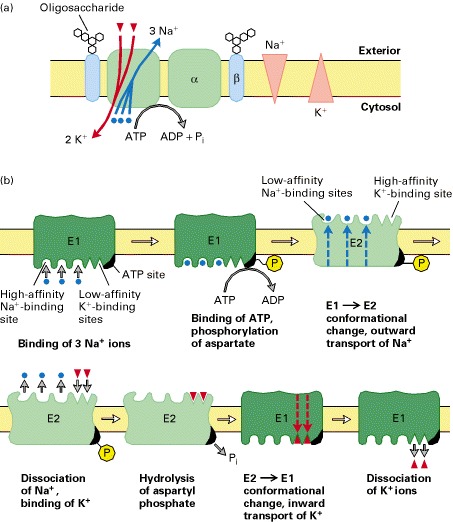Na+-K+ channel pumps: Difference between revisions
No edit summary |
No edit summary |
||
| Line 1: | Line 1: | ||
The [[Sodium|Na<sup>+</sup>]]/[[Potassium|K<sup>+</sup>]] pumps are found in the neuronal plasma membrane and are a type of primary active transporter<ref>Siegel GJ, Agranoff BW, Albers RW, et al. Basic Neurochemistry: Molecular, Cellular and Medical Aspects-Chapter 5-Membrane Transtport.6th edition. Philadelphia: Lippincott-Raven; 1999.</ref>. The role of the Na<sup>+</sup>/K<sup>+</sup> pump is to maintain the electrochemical gradient of Na<sup>+</sup> and K<sup>+. </sup>The Na<sup>+</sup>/K<sup>+</sup> pumps are a type of [[ATPase|ATPase]] they use the energy produced from the spliting of the [[ATP|ATP]] via [[Hydrolysis|hydrolysis]] to actively transport Na<sup>+</sup> out of the [[Axon|axon]] and pump K+ into the axon. The Na<sup>+</sup>/K<sup>+</sup> pump is a carrier protein, thus requires a change in conformation in order to move the [[Ions|ions]] across the membrane, for every 3 Na<sup>+</sup> pumped out there are 2 K<sup>+</sup> that have been pumped in. The Na/K+ pumps establish a [[Resting potential|resting potential]] of -70mv, this is a negative [[Voltage|voltage]] as the outside of the cell is more positive than commpared with the inside of the cell. The Na+/K+ pump is described as being electrogenic as it creates a change in electrical potential within the cell | The [[Sodium|Na<sup>+</sup>]]/[[Potassium|K<sup>+</sup>]] pumps are found in the neuronal plasma membrane and are a type of primary active transporter<ref>Siegel GJ, Agranoff BW, Albers RW, et al. Basic Neurochemistry: Molecular, Cellular and Medical Aspects-Chapter 5-Membrane Transtport.6th edition. Philadelphia: Lippincott-Raven; 1999.</ref>. The role of the Na<sup>+</sup>/K<sup>+</sup> pump is to maintain the electrochemical gradient of Na<sup>+</sup> and K<sup>+. </sup>The Na<sup>+</sup>/K<sup>+</sup> pumps are a type of [[ATPase|ATPase]] they use the energy produced from the spliting of the [[ATP|ATP]] via [[Hydrolysis|hydrolysis]] to actively transport Na<sup>+</sup> out of the [[Axon|axon]] and pump K+ into the axon. The Na<sup>+</sup>/K<sup>+</sup> pump is a carrier protein, thus requires a change in conformation in order to move the [[Ions|ions]] across the membrane, for every 3 Na<sup>+</sup> pumped out there are 2 K<sup>+</sup> that have been pumped in. The Na/K+ pumps establish a [[Resting potential|resting potential]] of -70mv, this is a negative [[Voltage|voltage]] as the outside of the cell is more positive than commpared with the inside of the cell. The Na<sup>+</sup>/K<sup>+</sup> pump is described as being electrogenic as it creates a change in electrical potential within the cell<ref>Alberts B., Johnson A., Lewis J., Raff. M, Roberts K. Walter P. Molecular Biology of The Cell- Chapter10-Membrane Structure. 5th Ed, New York: Garland Science. Taylor &amp;amp; Francis Group LLC. 2008</ref>. | ||
<br> | <br> | ||
== [[Image:Ch15f13.jpg|Model of the Na+/K+ pump]] == | |||
== How An Na+/K+ Pump Works == | == How An Na+/K+ Pump Works == | ||
The Na+/K+ pump has two different conformational states known as E1 and E2. | The Na+/K+ pump has two different conformational states known as E1 and E2. 3 Na<sup>+</sup> bind to the [[Intracellular|intracllular]] binding site, the [[Phosphorylation|phosphorlyation]] of the pump using the ATP causes the conformational change within the pump. The pump is now in conformational state E2, the 3 Na<sup>+</sup> are released outside of the cell. The binding of the 2 K<sup>+</sup> to the [[Extracellular|extracellular]] surface results in the [[Dephosphorylation|dephosphorylation]] of the pump returning the configuration back to E1, once in the E1 conformation the 2K<sup>+</sup> are released into the cell<ref>Darnell J.E., Lodish H., Berk. A, Zipursky L., Matsudaira P., Baltimore D. Cell Biology. 4th edition. 4th Ed, London: W.H.Freeman &amp;amp;amp; Co Ltd. 1999</ref>. | ||
=== === | === === | ||
=== Reference === | === Reference === | ||
<references /><br> | <references /><br> | ||
Revision as of 00:30, 5 December 2016
The Na+/K+ pumps are found in the neuronal plasma membrane and are a type of primary active transporter[1]. The role of the Na+/K+ pump is to maintain the electrochemical gradient of Na+ and K+. The Na+/K+ pumps are a type of ATPase they use the energy produced from the spliting of the ATP via hydrolysis to actively transport Na+ out of the axon and pump K+ into the axon. The Na+/K+ pump is a carrier protein, thus requires a change in conformation in order to move the ions across the membrane, for every 3 Na+ pumped out there are 2 K+ that have been pumped in. The Na/K+ pumps establish a resting potential of -70mv, this is a negative voltage as the outside of the cell is more positive than commpared with the inside of the cell. The Na+/K+ pump is described as being electrogenic as it creates a change in electrical potential within the cell[2].
How An Na+/K+ Pump Works
The Na+/K+ pump has two different conformational states known as E1 and E2. 3 Na+ bind to the intracllular binding site, the phosphorlyation of the pump using the ATP causes the conformational change within the pump. The pump is now in conformational state E2, the 3 Na+ are released outside of the cell. The binding of the 2 K+ to the extracellular surface results in the dephosphorylation of the pump returning the configuration back to E1, once in the E1 conformation the 2K+ are released into the cell[3].
Reference
- ↑ Siegel GJ, Agranoff BW, Albers RW, et al. Basic Neurochemistry: Molecular, Cellular and Medical Aspects-Chapter 5-Membrane Transtport.6th edition. Philadelphia: Lippincott-Raven; 1999.
- ↑ Alberts B., Johnson A., Lewis J., Raff. M, Roberts K. Walter P. Molecular Biology of The Cell- Chapter10-Membrane Structure. 5th Ed, New York: Garland Science. Taylor &amp; Francis Group LLC. 2008
- ↑ Darnell J.E., Lodish H., Berk. A, Zipursky L., Matsudaira P., Baltimore D. Cell Biology. 4th edition. 4th Ed, London: W.H.Freeman &amp;amp; Co Ltd. 1999
